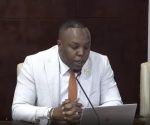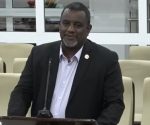Reconstruction priorities
 By Hilbert Haar
By Hilbert Haar
Roofs have to be repaired and businesses have to get back on their feet in the wake of Hurricane Irma. All that makes sense. But the real priorities for the country still lie elsewhere, as became evident from an address by Finance Minister Mike Ferrier last week. And those statements made sense as well.
Fixing the Princess Juliana International airport is the first priority to shift the sluggish post-Irma economy into higher gear, Ferrier said.
Currently, travelers in and out of St. Maarten do not pass through the airport terminal but through a couple of sturdy tents. It’s all pretty well organized but that’s not the issue.
The problem arises, Ferrier says, at the first hint that a hurricane of whichever category is heading for St. Maarten.
In such a scenario, the airport will be forced to dismantle those tents. Unfortunately, that process takes about five days. Putting these tents back together after the hurricane-danger has vanished takes another five days.
Obviously, the airport cannot afford to wait until the very last moment with the dismantling process. That means that, in a worst case scenario, the airport will have to close down seven and maybe more days before the possible arrival of a hurricane.
We don’t even need a real hurricane to set this process in motion, so it is quite possible that this exercise will have to be executed several times during the upcoming hurricane season.
That this will disrupt airport-business, arrivals and departures, needs no explanation. The only question is how big the damage is going to be.
So yeah, I can see that fixing the airport is a crucial element in the reconstruction process.
Minister Ferrier identified getting the major hotels and resorts back on line as the second priority. After all, arrivals have to stay somewhere and as long as room-capacity is handicapped, visitor-numbers will stay down.
The question is however whose responsibility it is to rebuild those resorts. Should the trust fund play a role in this process? Or is it up to the resorts to find the financial resources to get back in the game?
That becomes a political question. I figure that the relationships between politicians and resort-owners will play a role in the outcome.
Ferrier’s third call concerns the availability of soft loans for businesses. That’s understandable as well, because unemployment will become a huge headache for the penniless government. The faster businesses are, well, back in business, the faster employment opportunities will arise.
When businesses start doing business again and employees get back on the job, state revenue in terms of wage and turnover taxes will improve.
Those soft loans obviously require the cooperation from private sector financial institutions, or from the government that could put part of the €470 million that remains in the trust fund at the World Bank to good use.
It is worthwhile to note that the money in that trust fund is a gift and not a loan.
Should part of that money be used to support the private sector? I think it has two upsides. If that money can get businesses back on its feet, the government will see its tax-revenue increase. It could probably also bank the low-interest rates it would charge the private sector.
If the government opted to pump, say, €50 million ($60.5 million) in soft loans into the private sector at a modest 2 percent, it would collect annual interest of $1.21 million AND get more taxes in its coffers.
Like our minister of finance, I am not an accountant, so we’ll have to rely on the wisdom of real number-wizards in the decision making process that determines what St. Maarten will do with its recovery and reconstruction millions.























